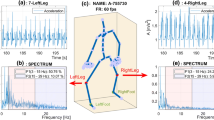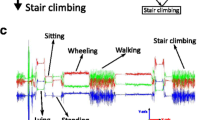Abstract
We propose a methodology to determine the occurrence of falls from among other common human movements. The source data is collected by wearable and mobile platforms based on three-axis accelerometers to measure subject kinematics. Our signal processing consists of preprocessing, pattern recognition and classification. One problem with data acquisition is the extensive variation in the morphology of acceleration signals of different patients and under various conditions. We explore several effective key features that can be used for classification of physical movements. Our objective is to enhance the accuracy of movement recognition. We employ classifiers based on neural networks and k-nearest neighbors. Our experimental results exhibit an average of 84% accuracy in movement tracking for four distinct activities over several test subjects.
Access this chapter
Tax calculation will be finalised at checkout
Purchases are for personal use only
Preview
Unable to display preview. Download preview PDF.
Similar content being viewed by others
References
J. Porteus and S. Brownsell, “Exploring Technologies for Independent Living for Older People, A report on the Anchor Trust/BT Telecare Research Project,” Anchor Trust, Fountain Court, Oxford Spires Business Park, Kidlington, Oxon 2000.
P. E. Ross, “Managing CARE Through the Air,” IEEE Spectrum, pp. 26–31, December 2004.
H. G. C. Kemper and R. Verschuur, “Validity and reliability of pedometers in habitual activity research,” Eur. J. Appl. Physiol, vol. 37, pp. 71–82, 1977.
P. Avons, P. Garthwaite, H. L. Davies, P. R. Myrgatroyd, and W. P. T. James, “Approaches to estimating physical activity in the community: Calorimetric validation of actometers and heart rate monitoring,” Eur. J. Clin. Nutr., vol. 42, pp. 185–196, 1988.
D. M. Karantonis, M. R. Narayanan, M. Mathie, N. H. Lovell, and B. G. Celler, “Implementation of a real-time human movement classifier using a triaxial accelerometer for ambulatory monitoring,” Information Technology in Biomedicine, IEEE Transactions on, vol. 10, pp. 156–167, 2006.
J. A. Anliker U Fau-Ward, P. Ward Ja Fau-Lukowicz, G. Lukowicz P Fau-Troster, F. Troster G Fau-Dolveck, M. Dolveck F Fau-Baer, F. Baer M Fau-Keita, E. B. Keita F Fau-Schenker, F. Schenker Eb Fau-Catarsi, L. Catarsi F Fau-Coluccini, A. Coluccini L Fau-Belardinelli, D. Belardinelli A Fau-Shklarski, M. Shklarski D Fau-Alon, E. Alon M Fau-Hirt, R. Hirt E Fau-Schmid, M. Schmid R Fau-Vuskovic, and M. Vuskovic, “AMON: a wearable multiparameter medical monitoring and alert system.”
K. Najafi B Fau-Aminian, A. Aminian K Fau-Paraschiv-Ionescu, F. Paraschiv-Ionescu A Fau-Loew, C. J. Loew F Fau-Bula, P. Bula Cj Fau-Robert, and P. Robert, “Ambulatory system for human motion analysis using a kinematic sensor: monitoring of daily physical activity in the elderly.”
K. Aminian, “Monitoring Human Movement with Body-Fixed Sensors and its Clinical Applications,” in Computational intelligence for movement sciences: neural networks and other emerging techniques, Rezaul Begg and M. Palaniswami, Eds.: Hershey, PA: Idea Group Pub., c2006, 2006.
M. P. Fargues, R. Cristi, and M. M. Vanderkamp, “Modeling and classification of biological signals using least squares Prony-SVD AR modeling [underwater acoustics],” 1993, pp. 445–448 vol.1.
L. Chuanjun, K. Latifur, and P. Balakrishnan, “Real-time classification of variable length multi-attribute motions.” vol. 10: Springer-Verlag New York, Inc., 2006, pp. 163–183.
G. L. Jonghun Baek, Wonbae Park, Byoung-Ju Yun, “Accelerometer Signal Processing for User Activity Detection,” in Knowledge-Based Intelligent Information and Engineering Systems. vol. 3215: Springer Berlin / Heidelberg, 2004.
T. Cover and P. Hart, “Nearest neighbor pattern classification,” Information Theory, IEEE Transactions on, vol. 13, pp. 21–27, 1967.
E. Wilson, “Backpropagation Learning for Systems with Discrete-Valued Functions,” in World Congress on Neural Networks San Diego, 1994.
Author information
Authors and Affiliations
Corresponding author
Editor information
Editors and Affiliations
Rights and permissions
Copyright information
© 2007 International Federation for Medical and Biological Engineering
About this paper
Cite this paper
Jafari, R., Li, W., Bajcsy, R., Glaser, S., Sastry, S. (2007). Physical Activity Monitoring for Assisted Living at Home. In: Leonhardt, S., Falck, T., Mähönen, P. (eds) 4th International Workshop on Wearable and Implantable Body Sensor Networks (BSN 2007). IFMBE Proceedings, vol 13. Springer, Berlin, Heidelberg. https://doi.org/10.1007/978-3-540-70994-7_37
Download citation
DOI: https://doi.org/10.1007/978-3-540-70994-7_37
Publisher Name: Springer, Berlin, Heidelberg
Print ISBN: 978-3-540-70993-0
Online ISBN: 978-3-540-70994-7
eBook Packages: EngineeringEngineering (R0)




